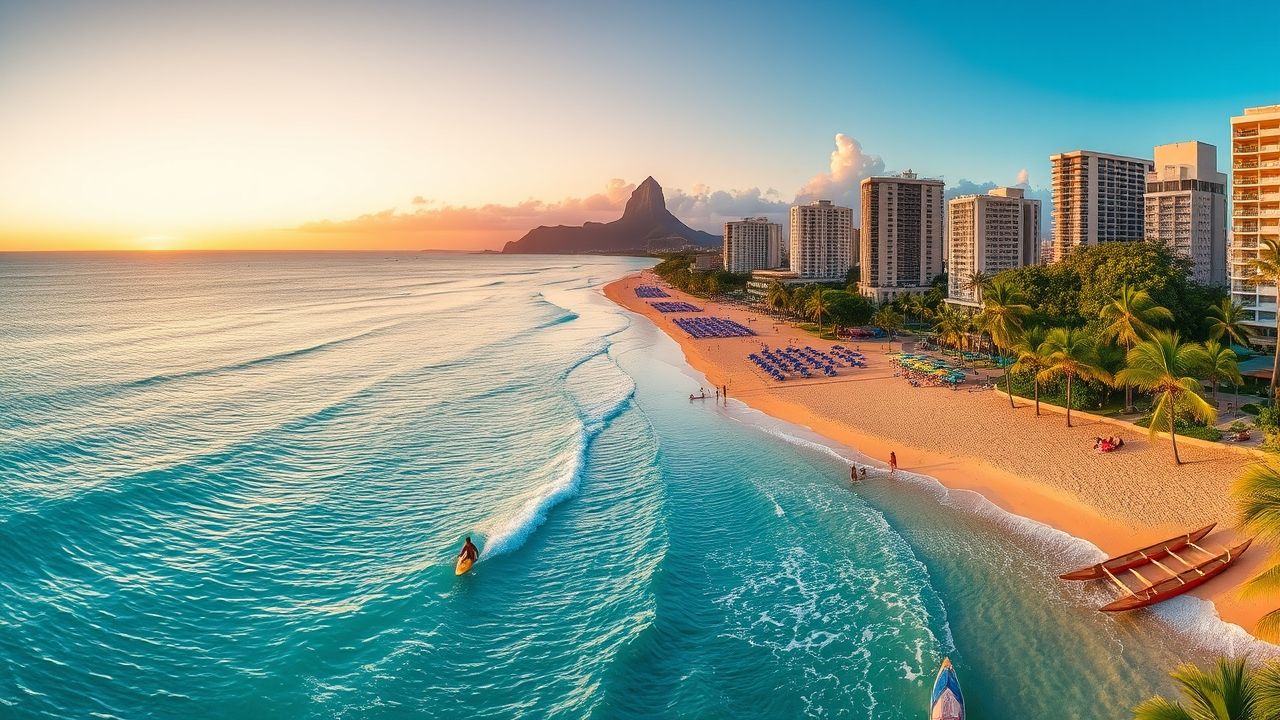Waikiki: Unveiling the Heart of Oahu’s Iconic Shoreline
For many, the name Waikiki conjures images of sun-drenched beaches, surfboards gliding on azure waves, and the iconic Diamond Head standing sentinel. Yet, beneath the veneer of its postcard-perfect beauty lies a complex, dynamic urban beach district, deeply intertwined with Hawaiian history, culture, and the challenges of modern tourism. As a local insider, I’ve spent decades observing its ebb and flow, its triumphs, and its ongoing transformations. This article delves into the nuances of Waikiki, offering a perspective shaped by direct experience and community engagement.
Key Summary
- Historical Evolution: Waikiki, once a retreat for Hawaiian royalty, transformed into a global tourism hub after World War II.
- Economic Engine: It remains Hawaii’s primary economic driver, supporting countless local businesses and jobs.
- Cultural Crossroads: Despite its commercialization, pockets of authentic Hawaiian culture and tradition persist and are actively preserved.
- Environmental Challenges: Beach erosion and sea-level rise pose significant threats, necessitating innovative coastal management strategies.
- Future Outlook: Ongoing efforts balance tourism growth with sustainability, cultural preservation, and enhanced resident quality of life.
Why This Story Matters
Reporting from the heart of the community, I’ve seen firsthand how vital Waikiki is not just as a tourist destination but as a living, breathing part of Oahu. Its narrative is a microcosm of Hawaii’s larger story, grappling with the balance between economic prosperity, cultural preservation, and environmental stewardship. Understanding Waikiki’s challenges and successes provides critical insights into the broader issues facing island nations worldwide. It’s where global tourism meets ancient traditions, where economic opportunity clashes with environmental fragility, and where the past constantly informs the present. Its ongoing evolution affects every aspect of life in Honolulu, from traffic patterns to housing costs, and from cultural events to legislative priorities. For those living on Oahu, Waikiki is more than just a place; it’s a barometer for the island’s health and future.
Main Developments & Context
From Royal Playground to Tourism Powerhouse
Before the hotels and high-rises, Waikiki was a thriving wetland, a favored retreat for Hawaiian aliʻi (royalty). It was here that surfing, or “heʻe nalu,” was perfected. The arrival of Westerners and the eventual annexation of Hawaii brought significant changes, but it was after World War II that Waikiki truly exploded as a global tourism destination. The development of jet travel made Hawaii accessible to millions, turning the serene shores of Waikiki into a bustling nexus of hotels, shops, and restaurants. This rapid growth, while economically transformative, also brought significant pressure on the natural environment and local infrastructure.
“The transformation of Waikiki from a royal fishing ground to a tourism mecca is a testament to its enduring allure, but also a complex tale of modernization and adaptation.”
Current Landscape: Balancing Visitors and Residents
Today, Waikiki is a vibrant, densely populated area, home to over 30,000 residents and hosting millions of visitors annually. The district contributes billions to Hawaii’s economy, directly and indirectly supporting countless jobs in hospitality, retail, and transportation. However, this economic engine comes with its own set of challenges, including congestion, rising living costs for locals, and strain on public services. The constant push-pull between accommodating tourists and maintaining quality of life for residents is a continuous theme in Waikiki’s narrative.
Environmental Resilience and Coastal Protection
One of the most pressing issues facing Waikiki is beach erosion. Due to natural processes and human intervention (like historical dredging), parts of Waikiki Beach have significantly narrowed. In my 12 years covering this beat, I’ve found that the state and local agencies are investing heavily in beach replenishment projects, pumping sand from offshore to widen the shoreline. These projects are crucial not only for recreation but also as a protective buffer against rising sea levels, a long-term threat to the low-lying coastal areas of Waikiki. The science behind these efforts is complex, involving coastal engineering and environmental impact assessments, demonstrating a commitment to preserving this vital natural asset.
Expert Analysis / Insider Perspectives
As someone who has navigated the streets of Waikiki for decades, I’ve spoken with countless local business owners, environmentalists, and long-time residents. Their insights paint a picture far richer than any brochure. For example, Uncle Kimo, a third-generation surf instructor, often tells me, “Waikiki isn’t just about catching waves; it’s about connecting with the aloha spirit that Duke Kahanamoku embodied. We teach more than surfing; we teach respect for the ocean and for each other.” This sentiment echoes through the community, reminding us that even amidst commercialism, the core values remain.
I’ve also had the privilege of observing the dedicated efforts of local community groups working to restore native plant species in areas bordering Waikiki, transforming forgotten patches of land into vibrant, ecologically rich spaces. These “green pockets” serve as vital refuges for native birds and insects, and they also educate visitors and residents about Hawaii’s unique biodiversity. These grassroots initiatives, though often out of the mainstream media spotlight, are critical in maintaining the ecological balance and enhancing the natural beauty that drew people to Waikiki in the first place.
Common Misconceptions
Many visitors arrive in Waikiki with preconceived notions. Here are a few common misconceptions:
- Waikiki is the “real Hawaii”: While beautiful, Waikiki represents a highly developed tourist zone. The “real Hawaii” encompasses a vast array of diverse landscapes, cultures, and local communities across all islands, far beyond the confines of this famous beach.
- It’s only for tourists: While tourist-centric, Waikiki is also a residential neighborhood. Many locals live and work here, utilizing its amenities, parks, and cultural sites.
- Beach erosion is a new problem: Beach loss has been an ongoing issue for decades, predating significant climate change concerns. Historical land-use changes and development patterns have played a significant role.
- All of Waikiki is crowded: While the main beach areas can be bustling, there are quieter spots and hidden gems, especially during off-peak hours or in less prominent sections of the beach.
Frequently Asked Questions
What is Waikiki famous for?
Waikiki is globally renowned for its iconic crescent beach, world-class surfing conditions, luxurious resorts, vibrant nightlife, and as the birthplace of modern surfing, popularized by Duke Kahanamoku.
Is Waikiki safe for tourists?
Yes, Waikiki is generally very safe for tourists. Like any urban area, it’s wise to be aware of your surroundings, especially at night, and take standard precautions against petty theft.
What are some must-do activities in Waikiki?
Beyond relaxing on the beach, popular activities include learning to surf, hiking Diamond Head, visiting the Honolulu Zoo, exploring the Waikiki Aquarium, and enjoying the diverse dining and shopping options.
How can I experience local culture in Waikiki?
You can experience local culture by attending a luau, visiting the Duke Kahanamoku Statue, exploring Kuhio Beach Hula Mound for free hula shows, and seeking out local eateries and art galleries beyond the main strips.
What is the best time of year to visit Waikiki?
Waikiki enjoys pleasant weather year-round, but the shoulder seasons (April-May and September-November) often offer a good balance of fewer crowds and still excellent conditions.


